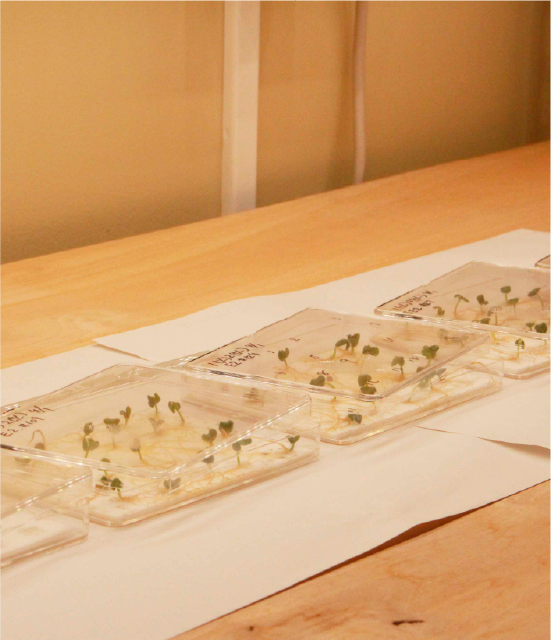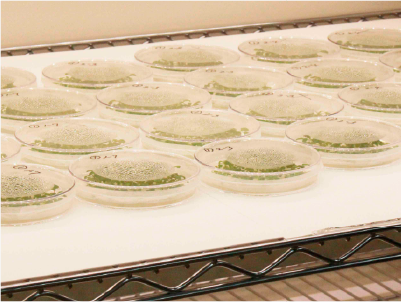Research
Eukaryotes receive environmental stimuli at their receptors which then is transmitted to the nucleus. In this condense and well-packed organelle called the nucleus, signals are somehow converted into gene expression upon need. It is however not known how these series of signal transduction in the nuclei is carried out.
By using the model plant Arabidopsis (Arabidopsis thaliana), we focus on signal transduction within the nucleus facilitating the plastic morphogenesis of cells and organs, in response to external stimuli.

 Understanding gene expression regulation in the nucleus
Understanding gene expression regulation in the nucleus
As a model for studying the regulatory mechanism of gene expression, we focus on the plastic morphogenesis during adaptation to different light conditions. For example, morphogenesis in response to light and dark is a physiological response that is executed under the control of gene expression in the nucleus through a series of light signal transduction from the photoreceptors. We are interested in the molecular regulation governing the signal transduction within the nucleus that transduces environmental signals to gene expression.

 Understanding molecular mechanisms involved in cell morphogenesis
Understanding molecular mechanisms involved in cell morphogenesis

Plant cells exhibit various shapes. Among them, root hairs and pollen tubes have been used as models to understand plant cell morphogenesis. Our research focuses on the molecular mechanisms involved in the establishment and maintenance of cell polarity during the process of root hair and pollen tube formation.
 Understanding gene expression
Understanding gene expression
regulation in the nucleus
The environment surrounding us is constantly changing. We are investigating the
molecular mechanisms, that we are wired
with, to respond to these changes. Specifically, we have focused on the COP9 signalosome
protein complex (CSN), which is
composed of eight subunits predominantly found in the nucleus. It is interesting to note
that CSN is widely conserved
among animals to plants. CSN responds to starvation and DNA damage in animals and to
light perception in plants. We have
hypothesized that CSN functions as the information hub to convert external stimuli into
nuclear events such as gene
expression regulation to execute physiological responses.
We use Arabidopsis thaliana, a model plant in dicots, to
analyze nuclear signaling governed by CSN. When plants respond to environmental changes,
they provoke a series of
regulatory mechanisms to cause physiological responses, beginning with receptors and
continuing through the regulation
of gene expression. The mechanisms that control this gene expression regulation include
“quantitative control” of
transcription factors that govern gene transcription, as well as “qualitative control”
of products that have already
been transcribed and on their way to be processed for maturation. We hypothesize that
CSN plays a key role in this
multistep regulatory mechanism, with the CSN5 subunit being a key factor in the
“quantitative control” of proteolysis,
while the CSN1 subunit is the key factor in the “qualitative control” of transcript
maturation. On the other hand, the
CSN1 subunit binds to complexes such as the spliceosome and the cleavage factor I, and
possesses a transcriptional
repressive function. Therefore, CSN1 subunit is considered to be involved in
“qualitative regulation” through the
regulation of transcript processing.
We believe that by elucidating the mechanisms that control plastic morphogenesis in
plants, we can elucidate the universal regulatory mechanisms of gene expression that are
conserved in a wide range of
organisms.
 Understanding molecular mechanisms
Understanding molecular mechanisms
involved in plant cell morphogenesis
Plant cells exhibit diverse morphologies that are adapted to their functions within
individual plant tissues and organs.
These morphologies also play a critical role in determining the overall shape of the
plant or organ. Generally, plant
cells grow through both diffuse growth and tip growth: in diffuse growth, cell expansion
occurs throughout the entire
cell, while in tip growth, expansion occurs exclusively at the tip, where materials for
the expanding plasma membrane
and cell wall are deposited. In Arabidopsis, cell polarity is first established in root
hair cells and pollen grains,
and then followed by tip growth to form root hairs and pollen tubes. Our research aims
to understand the molecular
mechanisms involved in the establishment and maintenance of cell polarity during the
process of root hair and pollen
tube formation. In particular, we focus on the regulatory roles of membrane lipids,
including phosphoinositides, in
plant cell morphogenesis.
Keywords:
plant cell morphogenesis, root hair, pollen, phosphoinositides, genetics, confocal laser
scanning microscopy
 Other researches
Other researches
・Molecular regulation of the fragrance of loquat (Eriobotrya japonica) flowers (ICR collaboration)
During the harsh winter season when there are no flowers around, loquat flowers release a sweet fragrance that goes for quite a distance. The three plant-lovers of ICR have been tracing the source of this fragrance. As if insects would be drawn to this flower, the three have put their humming together using their respective specialties to try to elucidate the molecular mechanism governing the fragrant components.
-

Koeduka T, Fujita Y, Furuta T, Suzuki H, Tsuge T, Matsui K. Aromatic amino acid decarboxylase is involved in volatile phenylacetaldehyde production in loquat (Eriobotrya japonica) flowers. Plant Biotechnol, (Tokyo), 34, 193-8 (2017). [Pubmed]
-

*Koeduka T, Kajiyama M, Furuta T, Suzuki H, Tsuge T, Matsui K., Characterization of an O-methyltransferase specific to guaiacol-type benzenoids from the flowers of loquat (Eriobotrya japonica). J Biosci Bioeng 122, 679-84 (2016). [Pubmed]
-

*Koeduka T, Kajiyama M, Suzuki H, Furuta T, Tsuge T, Matsui K., Benzenoid biosynthesis in the flowers of Eriobotrya japonica: molecular cloning and functional characterization of p-methoxybenzoic acid carboxyl methyltransferase. Planta 244, 725-36 (2016). [Pubmed]
・In search for the roots of Uji-Tea
The famous “Uji green tea” owes its brand to Mr. Soen Nagatani, from the neighboring Ujitawara town, who invented the early methods to produce lea with green color, in the mid-Edo period. In search for the origins of the Uji tea cultivars grown today, genomic analyses were performed on samples gathered from Korea, China and Japan.
-

Cho KH, Jo A, Tsuge T, Kim JC, Kim R, Yoon HS, *Kim GT., Comparative analysis of local green tea in Korea by STS-RFLP. J Life Sci 20, 1415-9 (2010).
-

Cho KH, Lee EJ, Tsuge T, Jo A, Kim JC, Cheong GW, Yoon HS, *Kim GT., Comparative genomic analysis of Korean and Japanese green tea trees by using molecular markers. Can J Plant Sci 90, 293-8 (2010).












